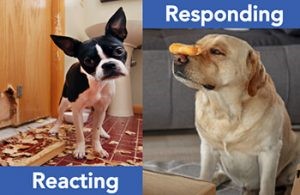Editor’s Note: This article first appeared on Melissa Eisler’s Mindful Minutes, a blog about how to live a mindful life, despite having a demanding schedule.
Have you ever had a short fuse, overreacted, or lost your cool in a stressful situation? If so, you’re not alone. It can be difficult to remain calm and collected when times are tense. Even with the best of intentions to do so, sometimes our words and actions run ahead of what we actually want to say and do—sometimes causing us trouble.
The way to stay calm in times of stress has to do with learning how to respond, rather than react. What’s the difference? While these words may be similar in semantics, the difference between the two can be profound.
A deep breath, a pause, or a brief moment of mindful presence is all it takes to remain cool in stressful situations. That pause can mean the difference between sending the entire situation or relationship soaring to greater heights, or falling down a slippery slope.
Let’s take a closer look at what the phrase respond vs. react represents, and learn some tools to help you respond to life’s circumstances—even when you’re triggered by stress—in a way that serves your well-being and everyone around you.
Reactions
 Reactions are instinctual and stem from the subconscious mind. There’s no filtering process when you react in a situation—you’re running on auto-pilot. When you react, you do and say things without thinking first and don’t consider the implications of what you do or say—you just act. Reactions are like a puppy who hasn’t been trained. That untrained puppy is going to bark at every dog it sees, jump at every passing neighbor, and then he’ll eat your dinner . . . as soon as he sees it.
Reactions are instinctual and stem from the subconscious mind. There’s no filtering process when you react in a situation—you’re running on auto-pilot. When you react, you do and say things without thinking first and don’t consider the implications of what you do or say—you just act. Reactions are like a puppy who hasn’t been trained. That untrained puppy is going to bark at every dog it sees, jump at every passing neighbor, and then he’ll eat your dinner . . . as soon as he sees it.
Responses
 Responses are more thoughtful. When you respond, you first explore in your mind the possible outcomes of your reply before saying a word. You may weigh the pros and cons and consider what would be best for yourself and others in the situation. Responses are more like the well-trained and well-behaved dog who comes when you call him, barks only when there’s a reason to bark, and waits patiently for his treat.
Responses are more thoughtful. When you respond, you first explore in your mind the possible outcomes of your reply before saying a word. You may weigh the pros and cons and consider what would be best for yourself and others in the situation. Responses are more like the well-trained and well-behaved dog who comes when you call him, barks only when there’s a reason to bark, and waits patiently for his treat.
Would you rather be the type of person who creates a calm and happy environment around you, like the well-behaved dog? Or the kind of person who is a wild card—totally unpredictable and can cause the people around you stress, like the untrained puppy?
 Being mindfully present when responding, means you can notice when something triggers you, and you continue to observe yourself as you have an emotional response to the situation. You are able to distance yourself from the experience and watch your mind react to it.
Being mindfully present when responding, means you can notice when something triggers you, and you continue to observe yourself as you have an emotional response to the situation. You are able to distance yourself from the experience and watch your mind react to it.
Take the Space When You’re Triggered
Adding that pause—that layer of observation, space, mindfulness, or whatever you want to call it—to the moment when you notice you’re triggered can mean the difference between strengthening or breaking a relationship, between a child, colleague, employee, or neighbor walking away feeling supported or disregarded. That space could mean a few deep breaths as you allow the reaction to fade and invite your balance to return. Or, it could mean taking a day or a week to cool down and reduce the charge of your emotional response. Every person and every situation will require a different way of doing this. Taking some space when you’re triggered gives you the time to make a conscious decision on your next step.
Have you ever acted on your anger, said something you didn’t mean, or did something you later regretted?
If you answered Yes to the previous question, have you ever experienced anger that faded with time, where after you stepped back, you no longer felt the charge? (If you answered No to the previous question, I want to know your secret . . .)
The reason most, if not all of you answered Yes, to that second question is because for most of us, emotions aren’t static . . . they come and go, and your responses to situations can be greatly different from one moment to the very next.
Often when we hear something that we don’t like or is unexpected in some way, the natural tendency is to get defensive or judge the situation quickly. This is the natural tendency of the human mind—to run on auto-pilot. An NYU Study found that a person decides how trustworthy another person is—judges someone else—in as little as 30 milliseconds. This is not enough time to consciously register a face, but it’s enough time for the brain to make a judgment.
Creating a short pause before responding to the trigger can help you disconnect from those automatic reactions and change the course of the situation completely.
Here’s an acronym I came up with to help myself and my clients in those moments when we notice we’re triggered, and you can use it, too. It’s called P.L.A.C.E.:
P: Pause
As soon as you notice you’re triggered, take a breath. For example, let’s say you get cut off on the highway. Before you spin into the typical road rage and get bent out of shape, as soon as you notice your energy shift, take a deep breath.
L: Label Your Reaction
What are you feeling? Is it frustration, insecurity, or something else? In the example of getting cut off on the highway, are you angry? Anxious?
A: Ask Yourself Why
What actually triggered you? Was it the event itself, or could it have been related to a previous judgment you had or a common trigger? This step invites you to bring awareness to your common triggers and blind spots. Often, the emotion is tied to something below the surface of the actual event.
In our example of being cut off, it likely isn’t the person cutting you off that’s making you angry . . . it’s likely that you’re going to be late and don’t have time to spare. When we get cut off . . . we go into reaction and anger mode. When we cut someone else off . . . it’s because we’re late to pick up the kids or late to a meeting. We’ve all been on both sides.
C: Choose a Skillful Response
This is a critical step—it’s where all the magic happens in the process. As you take that step back, consider . . . what matters most in this situation? What is my goal? And how can I respond in a productive way—a way that will move me closer to my goal? In our example, the most important thing is likely to arrive at your destination safely, and the best way to respond is most likely to let it go and keep yourself collected and attentive for the drive.
E: Empower Yourself
Empower yourself to move forward from that place of awareness so that you can invite a healthier, more ecological outcome for everyone involved.
You are building that self-reflective capacity—strengthening that muscle within yourself to respond with purpose.
Let me be clear. This is not easy and it takes practice. It’s impossible to be unreactive 100 percent of the time (at least I have not yet figured out how to do this). The goal is to decrease the amount of time you are reactive, and recover your centeredness more quickly. You must realize that you WILL go into auto-pilot when work gets stressful. The faster you can acknowledge when you’re triggered, the faster you’ll be able to regulate your nervous system, and get yourself back on track.
As with anything in life, it takes practice. Learning to become nonreactive is a continual process that gets easier over time. Rick Hanson is well-known for the phrase “Neurons that fire together, wire together.” In this context, what it means is that the more you can practice being calm and nonreactive and the more you invite responses rather than reactions, the better at it you become.
When we are not present and when we are stressed out, we are caught up in it all, and it’s more difficult to choose our response. We lose the boundary of our inner landscape with what’s happening externally and the context around us. When you are mindfully present, you have access to the space between the trigger and the response.
This is what this famous quote is referring to—this quote is often attributed to Viktor Frankl although he wasn’t the actual author.
“Between stimulus and response, there is a space. And in that space is our power to choose our response. In our response lies our growth and our freedom.”
Author Unknown.
The bottom line is, you have a choice. In stressful situations, you can either respond or react. You cannot do both simultaneously. Which will you choose?
ABOUT THE AUTHOR
 Melissa Eisler is an ICF-certified leadership and career coach, certified meditation and yoga instructor, and author. This article was originally published on her website, Mindful Minutes, which offers practical, relatable anecdotes and tips on how to bring balance and mindfulness into the busyness of the digital age. You can learn more about her coaching practice, and schedule a free, 30-minute coaching session at her website, www.melissaeisler.com.
Melissa Eisler is an ICF-certified leadership and career coach, certified meditation and yoga instructor, and author. This article was originally published on her website, Mindful Minutes, which offers practical, relatable anecdotes and tips on how to bring balance and mindfulness into the busyness of the digital age. You can learn more about her coaching practice, and schedule a free, 30-minute coaching session at her website, www.melissaeisler.com.


